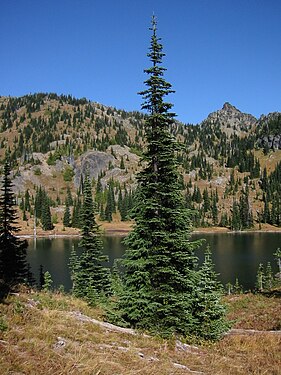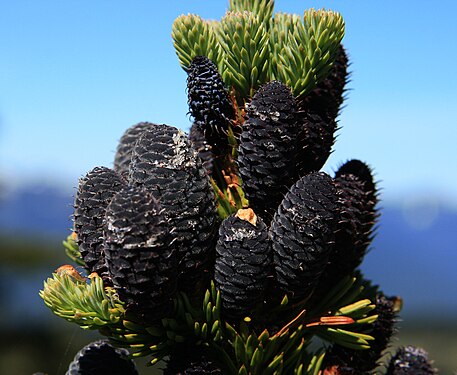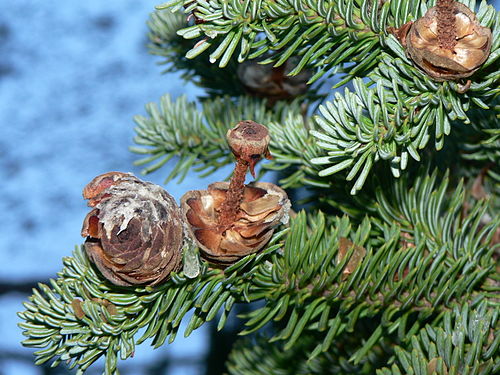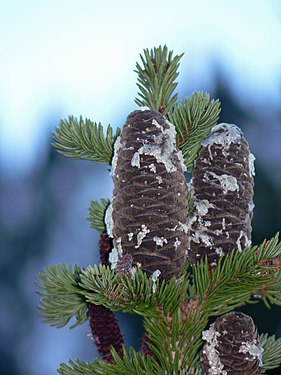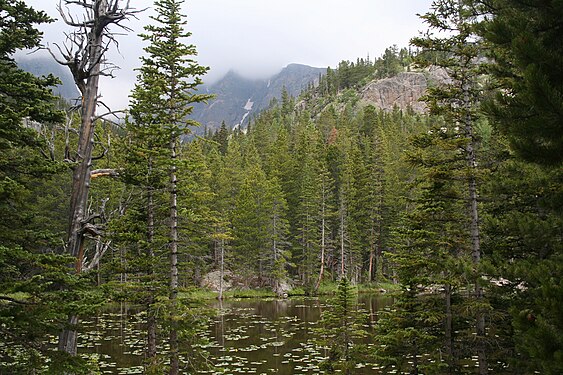Difference between revisions of "Abies lasiocarpa"
m (moved Subalpine Fir to Abies lasiocarpa: many common names) |
|||
| (2 intermediate revisions by one other user not shown) | |||
| Line 1: | Line 1: | ||
| − | + | {{SPlantbox | |
| − | | | + | |familia=Pinaceae |
| − | | | + | |genus=Abies |
| − | | | + | |species=lasiocarpa |
| − | | | + | |common_name=Coast Range Subalpine Fir, Alpine Fir, Rocky Mountain Fir |
| − | | | + | |name_ref=Flora - A Gardener's Encyclopedia |
| − | | | + | |habit=tree |
| − | | | + | |habit_ref=Flora - A Gardener's Encyclopedia |
| − | | | + | |Max ht box=60 |
| − | + | |Max ht metric=ft | |
| − | | | + | |height_ref=Flora - A Gardener's Encyclopedia |
| − | | | + | |Max wd box=12 |
| − | | | + | |Max wd metric=ft |
| − | | | + | |width_ref=Flora - A Gardener's Encyclopedia |
| − | | | + | |origin=W United States |
| − | | | + | |lifespan=perennial |
| − | | | + | |life_ref=Flora - A Gardener's Encyclopedia |
| − | | | + | |exposure=sun |
| − | | | + | |sun_ref=Flora - A Gardener's Encyclopedia |
| − | | | + | |water=moist |
| − | | | + | |features=evergreen, foliage |
| − | | | + | |Temp Metric=°F |
| − | | | + | |min_zone=4 |
| − | | | + | |usda_ref=Flora - A Gardener's Encyclopedia |
| − | | | + | |max_zone=9 |
| − | | | + | |sunset_zones=1-9, 14-17 |
| − | + | |image=Abies lasiocarpa 26011.JPG | |
| − | | | + | |image_width=180 |
| − | |||
}} | }} | ||
Native to high elevations in western US. Grows into a narrow, 60-90 foot tall steeple shaped tree in the wild under good, moist soil. In gardens it typically loses this narrow shape and height. Bluish-green needles, 1 to 1.5 inches long. | Native to high elevations in western US. Grows into a narrow, 60-90 foot tall steeple shaped tree in the wild under good, moist soil. In gardens it typically loses this narrow shape and height. Bluish-green needles, 1 to 1.5 inches long. | ||
| − | |||
| − | |||
| + | It is a medium-sized [[tree]] growing to 20 m tall, exceptionally to 40-50 m{{wp}} tall, with a trunk up to 1 m diameter, and a very narrow conic crown. The [[bark]] on young trees is smooth, gray, and with [[resin]] blisters, becoming rough and fissured or scaly on old trees{{wp}}. The [[leaf|leaves]] are flat needle-like, 1.5-3 cm long, glaucous green above with a broad stripe of [[stomata]], and two blue-white stomatal bands below; the fresh leaf scars are reddish. They are arranged spirally on the shoot, but with the leaf bases twisted to be arranged to the sides of and above the shoot, with few or none below the shoot{{wp}}. The [[conifer cone|cones]] are erect, 6-12 cm long, dark blackish-purple with fine yellow-brown pubescence, ripening brown and disintegrating to release the winged [[seed]]s in early fall{{wp}}. | ||
:''More information about this species can be found on the [[Abies|genus page]].'' | :''More information about this species can be found on the [[Abies|genus page]].'' | ||
| Line 46: | Line 44: | ||
==Varieties== | ==Varieties== | ||
| − | * Abies lasiocarpa var. | + | There are two to three [[taxon|taxa]]{{wp}} in Subalpine Fir, treated very differently by different authors: |
| + | *The '''Coast Range Subalpine Fir''' ''Abies lasiocarpa'' in the narrow sense, is the typical form of the species, occurring in the [[Pacific Coast Ranges]], the [[Olympic Mountains]] and the [[Cascade Range]] from southeast Alaska ([[Alaska Panhandle|Panhandle]] mountains) south to California{{wp}}. | ||
| + | *The '''Rocky Mountains Subalpine Fir''' is very closely related and of disputed status, being variously treated as a distinct species ''Abies bifolia'', as a [[variety (biology)|variety]] of Coast Range Subalpine Fir ''Abies lasiocarpa'' var. ''bifolia'', or not distinguished from typical ''A. lasiocarpa'' at all{{wp}}. It occurs in the [[Rocky Mountains]] from southeast Alaska (eastern [[Alaska Range]]) south to Colorado{{wp}}. It differs primarily in [[resin]] composition, and in the fresh leaf scars being yellow-brown, not reddish{{wp}}. The ''Flora of North America'' treats it as a distinct species (see external links, below); the [[United States Department of Agriculture|USDA]] includes it within ''A. lasiocarpa'' without distinction{{wp}}. | ||
| + | *The '''Corkbark Fir''' ''Abies lasiocarpa'' var. ''arizonica'' occurs in Arizona and New Mexico{{wp}}. It differs in thicker, [[Cork (material)|cork]]y [[bark]] and more strongly glaucous foliage{{wp}}. In resin composition it is closer to ''A. bifolia'' than to typical ''A. lasiocarpa'', though the combination "Abies bifolia var. arizonica" has not been formally published{{wp}}. The ''Flora of North America'' includes it within ''A. bifolia'' without distinction; the USDA treats it as a distinct variety of ''A. lasiocarpa''{{wp}}. | ||
==Gallery== | ==Gallery== | ||
| − | + | <gallery> | |
| + | File:SubalpineFir 7458.jpg | ||
| + | File:Abies lasiocarpa youngcones.jpg | ||
| + | File:Abies lasiocarpa 28161.JPG | ||
| + | File:Abies lasiocarpa 28151.JPG | ||
| + | File:SubalpineFir 3320.jpg | ||
| + | File:SubalpineFir 7753t.jpg | ||
| + | File:Abies lasiocarpa 15853.JPG | ||
| + | </gallery> | ||
| + | |||
| + | ''Abies lasiocarpa'' subsp. ''bifolia'' (A.Murray) Silba. Northern & central Rocky Mountains. | ||
| + | <gallery> | ||
| + | File:Abies lasiocarpa bifolia Picea engelmannii.jpg|Trees, with ''[[Picea engelmannii]]'', Mount Agassiz, Uinta Mts., Utah | ||
| + | File:Abies lasiocarpa bifolia Picea engelmannii2.jpg|Trees, with ''[[Picea engelmannii]]'', Mount Agassiz, Uinta Mts., Utah | ||
| + | File:Rocky Mountain Snow.JPG|Foliage with snow, Bear Lake, [[:Category:Rocky Mountain National Park|Rocky Mountain National Park]], Colorado | ||
| + | File:Bear Lake.JPG|Trees at Bear Lake, Rocky Mountain National Park, Colorado | ||
| + | File:Nymph Lake.jpg|Trees at Nymph Lake, Rocky Mountain National Park, Colorado | ||
| + | File:Ouzellake.jpg|Trees at Ouzel Lake, Rocky Mountain National Park, Colorado | ||
| + | File:Windswept trees, Glacier National Park.jpg|Treeline "krümmholz" tree at Glacier National Park, Montana | ||
| + | File:Abies lasiocarpa bifolia foliage.jpg|Foliage, Jasper NP, Alberta | ||
| + | </gallery> | ||
| + | ''Abies lasiocarpa'' subsp. ''arizonica'' (Merriam) A.E.Murray. Southern Rocky Mountains. | ||
<gallery> | <gallery> | ||
| − | + | File:Abies lasiocarpa subsp arizonica Santa Fe.jpg|Tree, near Santa Fe, New Mexico | |
| − | + | File:Abies lasiocarpa arizonica1.jpg|Trees | |
| − | + | File:Abies lasiocarpa arizonica2.jpg|Trunks | |
| + | File:Abies lasiocarpa arizonica3.jpg|Bark | ||
</gallery> | </gallery> | ||
==References== | ==References== | ||
| − | |||
<!--- xxxxx *Flora: The Gardener's Bible, by Sean Hogan. Global Book Publishing, 2003. ISBN 0881925381 --> | <!--- xxxxx *Flora: The Gardener's Bible, by Sean Hogan. Global Book Publishing, 2003. ISBN 0881925381 --> | ||
| − | + | *American Horticultural Society: A-Z Encyclopedia of Garden Plants, by Christopher Brickell, Judith D. Zuk. 1996. ISBN 0789419432 | |
<!--- xxxxx *Sunset National Garden Book. Sunset Books, Inc., 1997. ISBN 0376038608 --> | <!--- xxxxx *Sunset National Garden Book. Sunset Books, Inc., 1997. ISBN 0376038608 --> | ||
| Line 67: | Line 89: | ||
{{stub}} | {{stub}} | ||
| − | + | __NOTOC__ | |
| − | |||
| − | |||
Latest revision as of 17:15, 27 June 2010
| Habit | tree
| |
|---|---|---|
| Height: | ⇕ | 60 ft"ft" can not be assigned to a declared number type with value 60. |
| Width: | ⇔ | 12 ft"ft" can not be assigned to a declared number type with value 12. |
| Lifespan: | ⌛ | perennial |
| Origin: | ✈ | W United States |
| Exposure: | ☼ | sun |
|---|---|---|
| Water: | ◍ | moist |
| Features: | ✓ | evergreen, foliage |
| USDA Zones: | 4 to 9 | |
| Sunset Zones: | 1-9, 14-17 |
|
Pinaceae > |
Abies > |
Native to high elevations in western US. Grows into a narrow, 60-90 foot tall steeple shaped tree in the wild under good, moist soil. In gardens it typically loses this narrow shape and height. Bluish-green needles, 1 to 1.5 inches long.
It is a medium-sized tree growing to 20 m tall, exceptionally to 40-50 mwp tall, with a trunk up to 1 m diameter, and a very narrow conic crown. The bark on young trees is smooth, gray, and with resin blisters, becoming rough and fissured or scaly on old treeswp. The leaves are flat needle-like, 1.5-3 cm long, glaucous green above with a broad stripe of stomata, and two blue-white stomatal bands below; the fresh leaf scars are reddish. They are arranged spirally on the shoot, but with the leaf bases twisted to be arranged to the sides of and above the shoot, with few or none below the shootwp. The cones are erect, 6-12 cm long, dark blackish-purple with fine yellow-brown pubescence, ripening brown and disintegrating to release the winged seeds in early fallwp.
- More information about this species can be found on the genus page.
Cultivation
- Do you have cultivation info on this plant? Edit this section!
Propagation
- Do you have propagation info on this plant? Edit this section!
Pests and diseases
- Do you have pest and disease info on this plant? Edit this section!
Varieties
There are two to three taxawp in Subalpine Fir, treated very differently by different authors:
- The Coast Range Subalpine Fir Abies lasiocarpa in the narrow sense, is the typical form of the species, occurring in the Pacific Coast Ranges, the Olympic Mountains and the Cascade Range from southeast Alaska (Panhandle mountains) south to Californiawp.
- The Rocky Mountains Subalpine Fir is very closely related and of disputed status, being variously treated as a distinct species Abies bifolia, as a variety of Coast Range Subalpine Fir Abies lasiocarpa var. bifolia, or not distinguished from typical A. lasiocarpa at allwp. It occurs in the Rocky Mountains from southeast Alaska (eastern Alaska Range) south to Coloradowp. It differs primarily in resin composition, and in the fresh leaf scars being yellow-brown, not reddishwp. The Flora of North America treats it as a distinct species (see external links, below); the USDA includes it within A. lasiocarpa without distinctionwp.
- The Corkbark Fir Abies lasiocarpa var. arizonica occurs in Arizona and New Mexicowp. It differs in thicker, corky bark and more strongly glaucous foliagewp. In resin composition it is closer to A. bifolia than to typical A. lasiocarpa, though the combination "Abies bifolia var. arizonica" has not been formally publishedwp. The Flora of North America includes it within A. bifolia without distinction; the USDA treats it as a distinct variety of A. lasiocarpawp.
Gallery
Abies lasiocarpa subsp. bifolia (A.Murray) Silba. Northern & central Rocky Mountains.
Trees, with Picea engelmannii, Mount Agassiz, Uinta Mts., Utah
Trees, with Picea engelmannii, Mount Agassiz, Uinta Mts., Utah
Foliage with snow, Bear Lake, Rocky Mountain National Park, Colorado
Abies lasiocarpa subsp. arizonica (Merriam) A.E.Murray. Southern Rocky Mountains.
References
- American Horticultural Society: A-Z Encyclopedia of Garden Plants, by Christopher Brickell, Judith D. Zuk. 1996. ISBN 0789419432
External links
- w:Abies lasiocarpa. Some of the material on this page may be from Wikipedia, under the Creative Commons license.
- Abies lasiocarpa QR Code (Size 50, 100, 200, 500)

